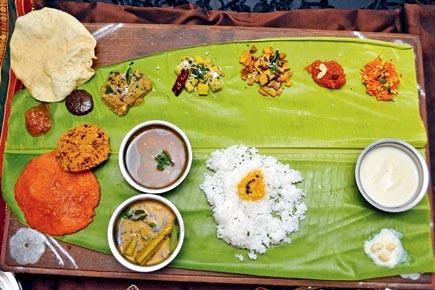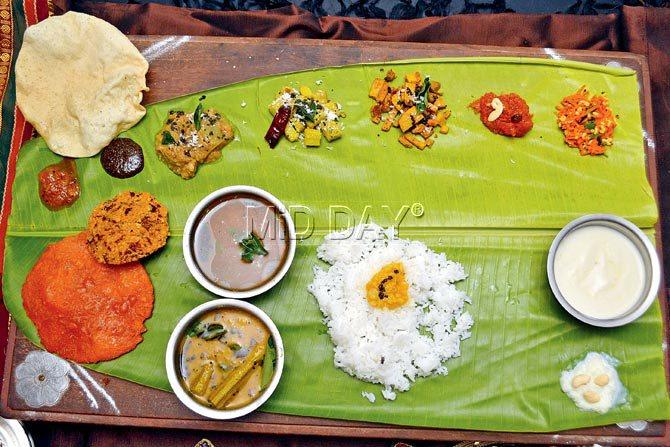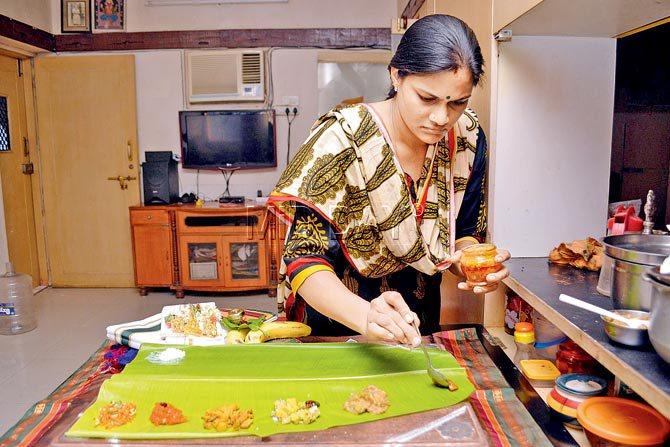Every Indian meal comes with its own set of eating and serving rules. Here's a ready reckoner for the next time you sit down for one

ADVERTISEMENT
We catch Gautam Purohit at a busy time. It is lunch hour at Gujarati eatery Thakkar Bhojnayala. But, the 70-year-old joint’s second-generation owner is eager to talk. The Kalbadevi institution started as a lodging, where people from Gujarat living the city, converged when they craved home-cooked food.
“Earlier, one sat on a chatai (mat) and the thali was placed on a patla (wooden table). Today, no one wants to sit down. Gujaratis love their food, and they don’t like to be bound by rules. The community likes to eat everything -- at one go. Salt is the first thing you are served, as it is the essence of life. Today, we put salt shakers on each table,” Purohit tells us.
Unlike the Gujaratis, the Assamese serve their food, course by course. “While there are no eating rules, the Assamese know that they must begin with lighter, subtle dishes and move up to the heavier one, which are served on a plantain leaf. So, the preference is usually vegetables, mashes and fritter, and then fish, chicken and pork. At the end of the meal, guests either bite into a lemon wedge or drinkits juice.”
Some cuisines, like Tamil, Bohri and Bengali, have more intricate traditions. Here’s how to eat across states without getting flummoxed.
Not without curd rice Tamil thali
Till date, a traditional Tamil thali is served on a banana leaf. “Have you ever noticed that your leaf has turned yellow by the end of your meal?” asks 35-year-old Aruna Karthik. “That’s the cholorophyl mixing with the food, making every morsel fresh,” adds Karthik, who runs a tiffin service, often cooking up entire thalis for occasions. She says everything from how you place the leaf, to how you serve the food has a rule that must be followed.

The uncut side of the leaf is placed on the left and those serving the food must do so, starting from placing the payasam on the bottom right, and then moving anti-clockwise. “The strict serving pattern is to ease confusion as there are many items. Diners are also conditioned to look for a particular item always at the same position,” says Karthik. The payasam is followed by cucumber raita on the top right corner of the leaf, followed by the sweet pachdi (chutney), two dry sabzies, usually made from locally sourced ingredients. Then, a gravy-laden vegetable, made with lentils is served. “This could be pumpkin, or snake gourd. The last dish on the top half is a curry leaf chutney, which aids digestion,” she explains, moving to the bottom left contingent.

Aruna Karthik from Thane serves a traditional Tamil thali on a banana leaf. Pic/ Datta Kumbhar
On the left will be a sweet, traditionally, a boondi laddu, Mysore pak or jhaangri (imarti). Next come the vadas -- medu or dal. “When a function is intimate, the medu vada is preferred. The dal vada can stay fresh all day, so that is usually on the menu at bigger gatherings.” After that the crunchy texture comes from the appalam (papad) and the main course takes seat in the middle of the bottom half. Toor dal, dollops of ghee and rice is served. This course is divided into three parts -- rice and sambhar, rice and rasam and rice and curd. “A Tamilian will not end his meal without curd rice. It is the only fitting end, we believe,” she laughs.
‘No second servings’ Bohri thaal
“You never make the thaal wait. So, once all the eaters have settled around in a circle, the thaal is placed on a tarakti (stand),” 61-year-old Zain Bhatri, tells us. “The youngest participant will offer salt on his palm and the oldest will take a pinch, and rest will follow. This is to get the saliva going. The process is repeated at the end, as salt also acts as an anti septic,” adds his wife, Yasmin, also 61.

The youngest eater at the Bohri thaal serves salt to the rest of the members. the eldest takes the first pinch
The thaal size is usually big enough for eight. The Bohri meal alternates sweet with savoury. First comes the sodanu (100 rice grains) cooked in sugar.
The eldest member takes the first morsel of every course. “It is the tameez of the thaal,” Zain says, recalling that his father would not allow latecomers.
It is time for the kharas (savoury), which could be chicken-minced kebabs, tandoor, pattice. Second servings, interestingly, are not allowed. “Perhaps because there is so much food, and no wastage is allowed. Neither can one skip a course,” says Zain, who hosts Bohri thaals in the city with food experience company Authenticook.
In comes a sweet dish such as mango souffle or malai khajla. “The next savoury item could be a thick gravy dish such as raan.” The main course is usually a rice dish. “Khudal palidu, which is toor dal and rice. We even serve bhartu (aubergine mash) with yoghurt, keema and fried papad,” she adds.

Zain and Yasmin Bhatri
Condiments include pickles like dry-fruit pickle, date chutney and orange pickle. We skip a heartbeat, when Zain tells us of a 20-year-old orange pickle his mother had made. “Two years ago, we gave it away to relatives because we couldn’t finish it. The quality was in tact,” he adds.
At the end, the youngest offers to make the eldest wash his hand, pouring water from a chilum chi lota. The person will take permission from the one on his right to wash his hands. “In our family, it was a rule not to discuss business during meals.”
Locally-sourced ingredients only Malvani thali
When it comes to Malvani cuisine, only locally sourced ingredients are used. “So, the core ingredients of most dishes will be rice, rice flour, dals (toor and moong dal). But the beauty of this cuisine is that every dish will still be true to the cuisine,” says Hetal Rao, a food blogger from Mud Island who does food pop-ups with Some Place Else.

The ingredients in Malvani cusine will be rice, rice flour, dals (toor and moong)
The breads include chawal ki roti (tandla chi bhakri), vade, rice, lentil, multigrain wheat, gram flour, fennel, cumin.
“We have ghavane or dosa, made of rice flour, water and salt. The dry dishes are sprouts, fish kolame che sukke, and matke chi usaal,” says Rao, adding that the rice is eaten in three portions with different condiments. “Waran (moli daal) is enjoyed as a palate cleanser. While the curry is not spicy, it has a burst of flavours, thanks to the cumin seeds. The second is the mutton or lentil curry, which is thicker and spicer. Last is the sol kadi. It is a watery palate cleanser,” she says.

Hetal Rao
Dessert is eaten with the meal. “The choice is between kheer, modak and dhondus (a cake made in the monsoon using cucumber, rawa, jaggery and peanut). It is similar to the Gujarati handvo.”
‘Bitter gourd as palate cleanser’ Bengali thali
“Bengalis, like the dialect, are a sweet people. But we begin our meal with something bitter,” says food blogger and author of Planet Gastronomy -- 100 Most Popular Global Recipes, Ananya Banerjee.

Food Blogger Ananya Banerjee says Bengalis love to end their meal with a ‘Culcatta’ paan
It’s traditionally served on a banana leaf, in some cases, earthen ware, or bellmetal utenstils. “Our first bite is a karela (bitter gourd) bhaja (fritter) to cleanse the palate. Or, the shukto (a bitter vegetable made of karela) and eaten with salt and ghee.” The second course includes a platter of fried bhajas, including potato, aubergine, eaten with daal. “This is followed by ghonto (curry with vegetables). We eat this with rice. The lucchi is preferred during dinner,” she explains, adding that a non-veg serving of the ghonto will come with a fish head. Next comes jhol, for instance macher jhol -- a watery curry with panch phoran masala. Mangsho is a richer curry, and eaten with rice. On rare occasions, kalia (rich Mughlai-influenced curry with tomatoes, onion, garlic) is served. After the curries, papad is devoured only with chutney followed by misti doi. “The meal ends on a sweet note, which could be rossogulla, rasmalai or chanar payesh. And, the Calcutta paan, of course.”
 Subscribe today by clicking the link and stay updated with the latest news!" Click here!
Subscribe today by clicking the link and stay updated with the latest news!" Click here!







